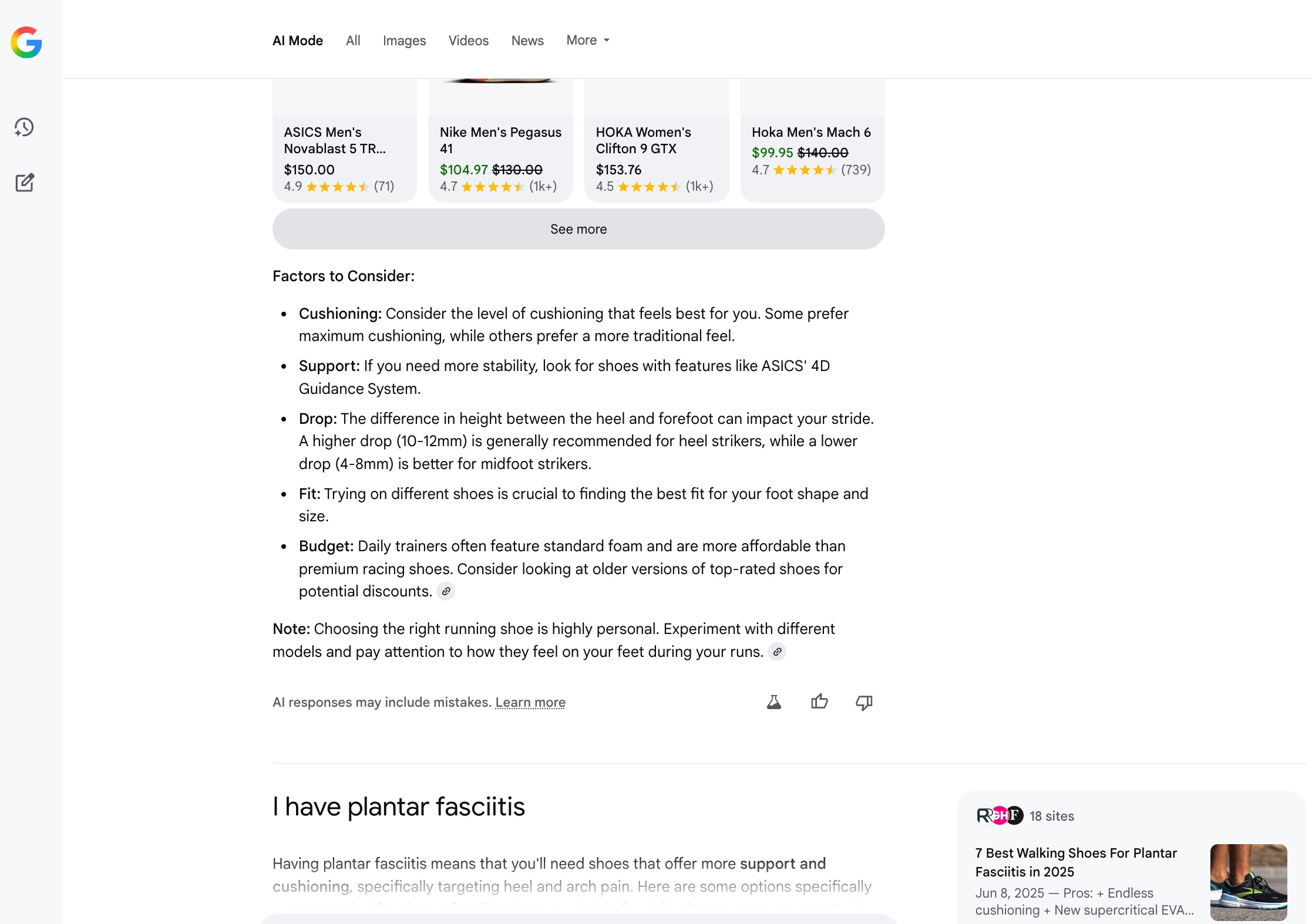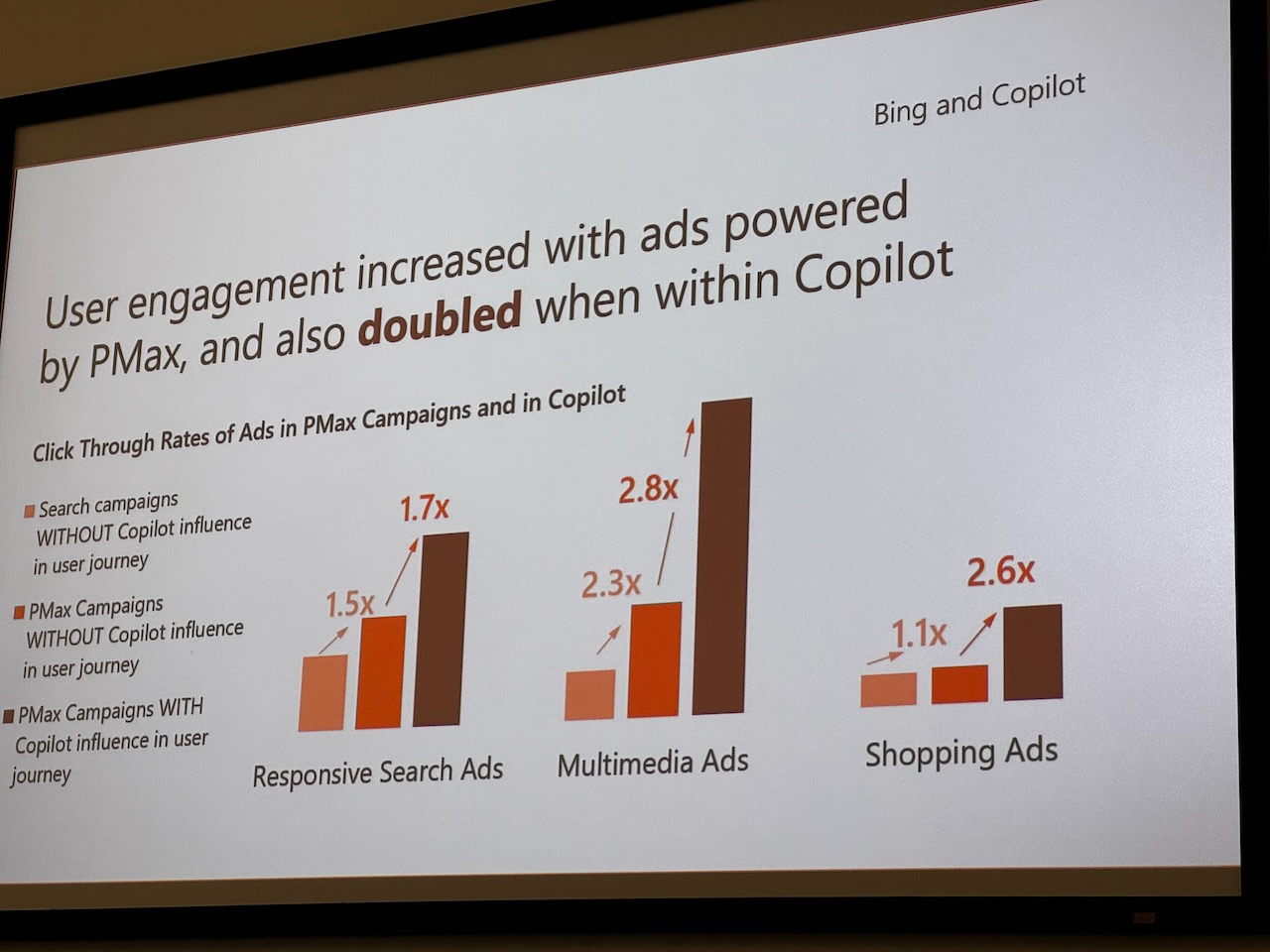Google AI Mode, which officially launched in May 2025 and is now available to all U.S. users without a waitlist, represents a significant step forward in how we engage with search.
Powered by Gemini 2.5, this new interface moves beyond AI Overviews by introducing a persistent, conversational assistant that blends AI-generated insights with traditional search results.
Users can toggle between classic results and AI-driven summaries, follow up on queries, and explore longer, more exploratory conversations, all within a single interface.
Unlike AI Overviews or the earlier Search Generative Experience (SGE), which provided a single AI-generated answer for a traditional search query, AI Mode is more similar to ChatGPT in that it fosters a conversational approach to finding answers.
This marks a change in how people interact with search, moving from short, isolated keywords to more natural prompts that sound like how we talk and think.
AI Mode supports rich interactions and longer queries, encouraging a deeper and more nuanced engagement with information. And when user behavior shifts, advertisers must adapt how they reach users with relevant solutions and offers.
Think back to how Enhanced Campaigns forced advertisers to get ready for the explosion in mobile device usage.
We’re now at another junction where advertisers and Google must work together to evolve how we operate to remain successful. That means reconsidering everything from targeting and attribution to monetization and ad design.
 AI Mode Interface (Screenshot from Google, June 2025)
AI Mode Interface (Screenshot from Google, June 2025)In this post, I share my thoughts on what AI Mode signals for the future of search, how it challenges long-standing digital advertising models, and why marketers need to adapt fast or risk being left behind.
Strategic Motives: Innovation Vs. Defense
Is Google pushing AI Mode because it sees an opportunity or because it’s responding to pressure from OpenAI and others? The answer is likely both.
Google’s technical leadership is well-established.
DeepMind, a Google company, helped invent the transformer model that underpins GPT. Its Gemini family of models has matured rapidly.
At Google Marketing Live 2025, Sundar Pichai stated that Gemini had taken the lead as the top-performing model, a claim supported by LM Arena’s leaderboard.
Still, Google moves cautiously. As a market leader under regulatory scrutiny, it can’t afford missteps.
The innovation is real, but so is the strategy to protect its dominance by making AI part of its core products before others can take the lead.
I believe Google’s technology is among the best in the world. However, as the company is in the spotlight, they have to be more measured.
Regulatory scrutiny, scale, and legacy expectations mean it can’t move as fast as emerging players, but that doesn’t mean it will always be chasing the lead.
Prompt Complexity And Memory: The Challenge Of Targeting
How users like to find answers is changing from clicking around on a search results page to interacting with an AI assistant.
This evolution from search engine to answer engine introduces a new layer of complexity for advertisers. Prompts in AI Mode aren’t just text; they’re conversations rich with personal context and memory.
Take a user engaging in a long session with AI Mode. Their conversation might include several prompts in a row like this:
- “I’m running my first marathon in LA and need good shoes. What do you recommend?”
- “By the way, I have plantar fasciitis. I’m not trying to break records, I just need something that won’t wreck my knees.”
- “I’m not a fan of bland colors. What brands have something more vibrant in their current line-up?”
The assistant understands the goal and tailors responses to match medical considerations, intent, and emotional tone.
It might include surface stability shoes, recommended inserts, and even factor in training timelines or the expected weather in the city where the marathon will take place.
Now contrast that with a short prompt: “running shoes.”
Simple on the surface, except the assistant remembers that just yesterday, I was at the Adidas store talking to a clerk about shoe fit via my bee.computer wearable, and I used my Ray-Ban Meta glasses to snap a few images of colors I liked.
While this use case is not quite there yet in the real world, I am personally using this technology now, and it’s just a matter of time until all the pieces are connected and the advertiser scenario I described will become real.
Then we’ll see the assistant pick up right where I left off, using multimodal memory to enrich the response with past conversations and visual preferences.
Neither of these interactions can be matched with traditional keyword-based targeting. The assistant’s memory and personalization turn every query into a unique moment.
For advertisers, it’s not just about what was typed; it’s about what the assistant knows.
This creates a richer opportunity for advertisers, but there is a challenge related to targeting because Google Ads was built for keyword advertising, not prompt advertising – and this creates a disconnect.
→ Curious how marketers are adapting to these shifts? Check out the 2025 State Of AI In Marketing report for the data and insights.
From Keywords To Prompts: Why The Old Model No Longer Fits
Google Ads was initially built around a simple idea: Match ads to user searches through keywords.
Advertisers bid on terms users might type into the search bar (like “running shoes” or “cheap flights”), and the system will serve relevant ads based on those inputs.
But AI Mode is changing the language of search. Instead of short, isolated keywords, users are starting to use full, conversational prompts that reflect how they naturally speak.
These prompts are often longer, more specific, and packed with nuance that the original ad system wasn’t designed to handle.
To keep things running, Google has introduced a behind-the-scenes workaround: “synthetic keywords.”
These are machine-generated representations that attempt to map modern prompts back into the keyword framework advertisers still rely on. It’s a clever patch, but ultimately a temporary one.
As prompts continue to evolve in complexity and variety, and as memory and personalization shape every query, the keyword as a stable targeting anchor is becoming harder to rely on.
That puts pressure on the entire ad ecosystem. The old model is still functioning, but it’s increasingly out of sync with how people search.
A new system, one built natively for prompts, context, and memory, will eventually need to take its place.
Rethinking Ads In AI Mode: What Comes After Clicks?
The shift toward AI-assisted browsing brings another major challenge: fewer clicks.
If users get what they need from the assistant itself, the need to visit websites diminishes, weakening the foundations of the cost-per-click (CPC) business model.
 Slide by Microsoft at Accelerate Roadshow LA, June 2025
Slide by Microsoft at Accelerate Roadshow LA, June 2025But clicks will be more relevant because, unlike in the past, where a click was a user’s initial exploration of your offer, they will now be better informed and further along in their research by the time they visit your site for the first time.
Microsoft research found that purchasing behaviors increased by 53% within 30 minutes of a Copilot interaction, underscoring just how powerful, timely, and AI-embedded suggestions can be.
To stay relevant, ads must feel like part of the conversation. They can’t be disruptive or detached. They need to be embedded, responsive, and helpful, appearing when and where they make the most sense.
Newer performance data shows that ad engagement doubled in some formats when served through Copilot, especially in PMax-powered Shopping and Multimedia Ads.
Crucially, Microsoft has dialed back the volume of ad impressions in Copilot, choosing instead to show ads only when they’re predicted to be highly relevant and useful.
The result? Fewer, better-placed ads that drive stronger outcomes, a model that hints at where Google AI Mode could be headed.
Google has done this before. Its introduction of AdWords transformed ads from flashy banners into useful information. AI Mode demands a similar evolution, one that turns helpfulness into performance.
So, if the traditional way Google makes money becomes broken, let’s look at some options for how they might bridge the gap.
→ Understand where marketing teams are realizing value and where key gaps remain. Check out the 2025 State Of AI In Marketing whitepaper.
Conversion Inside The Conversation: The Rise Of Affiliate Models And Agents
The most frustrating part for consumers using AI agents to find something to buy is the final step after determining what they want.
Now, they need to hunt for where to buy it, enter a credit card, and deal with the usual minutiae of buying something online.
A better user experience, especially for smaller purchases, would be to tell the agent, “I like it, buy it!” and have the item arrive at your doorstep the next day.
While this zero-click scenario is the best user experience, it is also the most problematic in a CPC world.
This opens the door for reconsidering affiliate and commission-based advertising models. Instead of paying for attention, advertisers pay for action.
Ads become decision-making partners, not just traffic generators. It’s a better fit for how assistants work: focused, efficient, and user-first.
While this wouldn’t be Google’s first attempt at commission-based monetization (previous efforts, such as Buy on Google, Shopping Actions, and Google Express, ultimately shut down due to limited merchant adoption and weak consumer uptake), those models lacked the personalized context that AI Mode now enables.
Even vertical-specific experiments like commission bidding for Hotel Price Ads (retired in 2024) followed the same pattern: strong in theory, but missing the behavioral depth to sustain engagement.
With memory-driven prompts, real-time user needs, and multimodal signals in play, the conditions may finally be right for performance-based pricing to scale in a meaningful, consumer-aligned way.
Monetization Models: Why Subscriptions Aren’t The Future
Monetizing AI-powered search is a hot topic. Startups like Neeva by Sridhar Ramaswamy (Former Google Ads Chief) attempted to replace ads with subscriptions, but user adoption fell short.
Even OpenAI, with its paid ChatGPT Pro tier, sees a vast majority of users opting for free access.
The pattern is clear: Most users won’t pay for general-purpose search tools. Even companies leading in AI anticipate that advertising will remain the dominant revenue stream.
Google’s ad model, tested and refined for decades, is still the best-positioned approach – if it can evolve to match the new user behavior.
Ads In AI Mode
Google has already said it will have ads in AI mode.
To maximize the likelihood of your ads appearing in this environment, it’s advisable to utilize Google’s AI-centric tools, including AI Max in search campaigns, Performance Max, and Demand Gen.
Employing broad match keywords is also crucial, as they facilitate connections with conversational prompts rather than traditional keywords.
However, with the potential decrease in click-through rates, a pertinent question arises: Can fewer clicks on ads sustain the revenue model?
Despite this challenge, I anticipate that advertising will remain the primary revenue stream, even within AI Mode.
It’s noteworthy that OpenAI’s CEO, Sam Altman, has expressed reservations about incorporating ads into AI experiences.
In a conversation with Ben Thompson, Altman stated:
“Currently, I am more excited to figure out how we can charge people a lot of money for a really great automated software engineer or other kind of agent than I am making some number of dimes with an advertising-based model… I kinda just don’t like ads that much.”
Similarly, Google’s co-founders, Larry Page and Sergey Brin, initially opposed the idea of advertising on their search engine. In their 1998 research paper, “The Anatomy of a Large-Scale Hypertextual Web Search Engine,” they wrote:
“We expect that advertising-funded search engines will be inherently biased towards the advertisers and away from the needs of the consumers.”
Despite these initial reservations, both OpenAI and Google have recognized the practicalities of monetization. Google makes nearly 78% of its revenue from ads as of 2024, illustrating its evolution from the original stance of its founders.
So, while the methods and philosophies around advertising in AI experiences have evolved, the necessity for effective monetization strategies remains paramount.
Conclusion: Betting On AI-Powered Ad Innovation
Soon, helping consumers at the moment of relevance won’t be about search and keywords anymore; it’ll be about context, and AI-powered interactions driven by memory, intent, and dialogue.
The early signals are promising: Users respond better when ads are useful, not intrusive.
Microsoft’s experience with Copilot shows that when generative systems deliver fewer but more relevant ads, engagement and conversions rise.
Google’s opportunity is to take those lessons further, baking utility and timing into its AI-native monetization engine.
It’s not about building the flashiest assistant; it’s about earning trust at the moments that matter.
If the assistant can deliver value and drive outcomes without breaking the flow, that’s the model that wins.
I have no doubt that Google and other ad platforms will find ways to appropriately monetize these advertising opportunities, even if there will be fewer impressions for each consumer journey.
The fundamentals of advertising at the moment of relevance haven’t changed, but our tactics will need to evolve fast. Prompts, not keywords, are the new starting point – and that changes the game.
More Resources:
Featured Image: Lana Sham/Shutterstock








